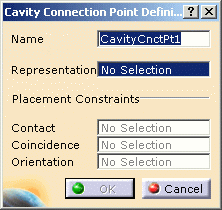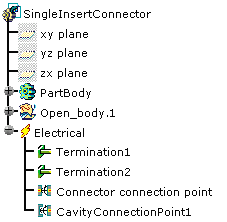A cavity connection point is used to specify how a device is placed in a cavity when making an electrical connection.
-
Click Define Cavity Connection Point
 .
. -
Select the electrical device where you want the cavity connection point to be defined.
The Cavity Connection Point Definition dialog box opens: 
-
Enter a value in the Name field.
-
Select a Representation, for example a pocket, a pad, a face...
-
Optionally, set a Contact constraint, for example a surface or a point.
-
Optionally, set a Coincidence constraint, for example a surface, a line or an axis.
-
Optionally, set an Orientation constraint, for example a surface, a line or an axis.
The orientation is used to constrain the rotation i.e. the third degree of liberty. -
Click OK to validate.
The specification tree is updated. 
For more information about the placement constraints, refer to Using Assembly Constraints.
You can add cavity connection points to:
- Connector shells
- Single insert connectors, multi insert connectors, studs, terminal strips, terminal blocks
- Filler plugs
- Contacts.